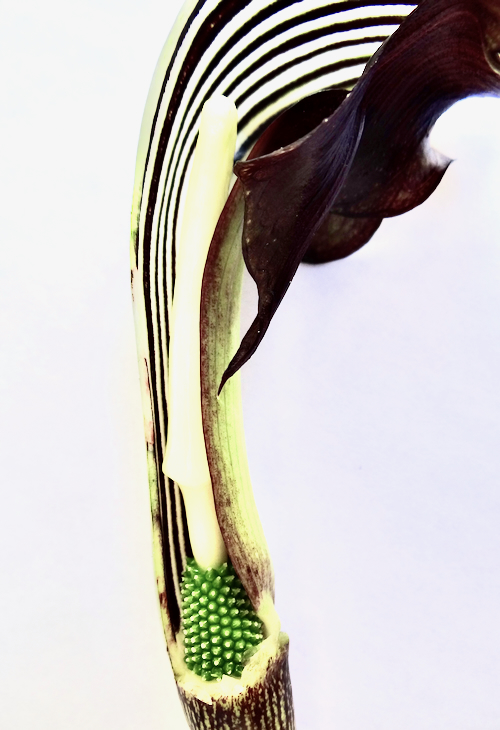
Plant of the Month June 2023
GENERAL INFORMATION:
I was fascinated by “Jack-in-the-Pulpits” as a child in England. Arum maculatum grew in our woods. We also called it Lords-and-Ladies and Cuckoo-Pint. Was there something improper about the plant? I recently learned “pint” was a shortening of “pintle” (penis!) My Grandmother had a scary, smelly Voodoo-Lily (Amorphophallus konjak) in her garden. Now I find Arisaema triphyllum growing in our Ontario woodlands.
All three are among 140 genera of the Aroid family, or Araceae. These are characterized by a large, frequently colourful, upright to curled over bract called a spathe (pulpit). This encloses the spadix (Jack), which is an upright thick stalk bearing numerous male and/or female flowers. When teaching, I liked to show teen-aged students a small Arisaema triphyllum and tell them it was a male plant. It would be female the next year if it grew big and strong enough! Seed production might exhaust it and it would return to being a male plant! (Paradioecious, changing back and forth.)
Synonym: Arisaema praecox. Arisaema sieboldii. Arum ringens.
Common Name: Japanese Cobra Lily.
Cultivars:
Arisaema ringens ‘Black Mamba’ – dark purple pseudostems.
Arisaema ringens var. glaucescens – green spathe.

Arisaema ringens.
Life Cycle: Perennial, growing from disc shaped tubers.
Size: to 0.5m x 0.5m.
Bloom Time: The plant usually emerges during the first week of May in Toronto. The inflorescences open soon after, in mid May to June.

Arisaema ringens early May.
Leaves: A mottled purple pseudostem bears 2 long lasting glossy trifoliate leaves. The 3 leaflets are oval to elliptical and about 15 cm long. The leaves die down in late summer if no seeds develop.

Arisaema ringens - leaves.
Flower Colour & Size: Long lasting Arum flowers. The thick spathe, striped in green, purple and white curls forward and down, looking like the head of a cobra.

Arisaema ringens – four inflorescences.
The glimpse of the shiny purple interior gives the impression of 2 eyes. The creamy coloured spadix is hidden inside. The tiny flowers are usually male or female with an occasional hermaphrodite plant.


Arisaema ringens – closeup. Arisaema ringens – female.
Fruit: Red berries in fall, if male and female plants present. I have had berries once which did not develop.
Range: China, Japan, Korea.
Habitat: Lowland woods.
CULTIVATION:
Plant: Plant dormant tubers in fall, at least 10 cm deep with a handful of gravel mixed below.
Light: Part to full shade.
Soil: Humus rich, well drained soil. Avoid heavy clay.
Water: Medium moisture to wet soil, though my plants dry out frequently.
USDA Hardiness: Zones 5-9.
Companion planting: Woodland plants – Ferns, Hosta, Stylophorum diphyllum (wood-poppy), and if light shade, Hakonechloa macra 'Aureola' (Japanese forest grass).
Propagation: Dig plant in fall and separate tubers - replant. From seed: Remove fleshy coat. (Use gloves.) Gently scarify. Soak in hand-hot water for 24 hours. Plant and keep at 20°C. Let seedlings grow for as long as possible, feeding with an all purpose fertilizer. Keep at 4°C over winter.
Problems: None noted. The plant is poisonous.
References:
https://www.missouribotanicalgarden.org/PlantFinder
https://onrockgarden.com/index.php/germination-guide
https://pfaf.org/user/Plant.aspx?LatinName=Arisaema+ringens
https://en.wikipedia.org/wiki/Araceae
https://www.plantdelights.com/blogs/articles/arisaema-arisaema-arisaema
Text and images supplied by Anna Leggatt (Toronto Master Gardener)
